National
Risk of community transmission increases in Kathmandu despite expansion in testing criteria
About 5,000 persons enter the Valley every day despite restrictions on movement from one district to another.
Arjun Poudel
On Monday, 35-year-old Jibach Kumar Das from Jaleshwor Municipality, Mahottari, visited Sukraraj Tropical and Infectious Disease Hospital for a coronavirus test.
Das, who works at a butcher shop in Kathmandu, had recently returned from his village, a Covid-19 hotspot, and sought the test following pressure from his landlord. But he was not tested.
“We didn’t test him as he didn’t show symptoms of Covid-19 despite returning from a hotspot,” a doctor collecting swab samples told the Post requesting anonymity as he was not authorised to speak to the media. “We couldn’t perform the test despite knowing that he came from a Covid-19 hotspot and there was risk in turning him away untested.”
According to a directive from the Ministry of Health and Population, only those who show symptoms of Covid-19, have been in close contact with the infected, or come from a community where the virus recently spread can be tested.
Around 1,200 people, most of them returnees from the Terai, seek tests at the hospital every day, but only one-fourth get tested. This ratio has in fact increased in the past two days and could increase further as the testing criteria was revised earlier this week.
“From Sunday, we have expanded the criteria to accommodate even those who are asymptomatic and have returned from areas where the virus has been detected in the recent past,” said Dr Anup Bastola, spokesperson for the hospital.
But as 99 percent of Covid-19 cases have been reported to be asymptomatic in Nepal, according to the ministry, people like Jibach Kumar Das still risk transmitting the virus.
With the lockdown eased, thousands of people are entering Kathmandu everyday through various entry points. “Over 5,000 people enter the Kathmandu Valley everyday on emergency vehicles, food and cargo trucks and also by getting special permits,” Bhim Prasad Dhakal, senior superintendent at Metropolitan Traffic Police Division, told the Post.
All this goes on despite restrictions on movement from one district to another.
A government doctor at Sukraraj Tropical and Infectious Disease Hospital, requesting anonymity, accepts that the risk of an outbreak in Kathmandu is increasing.
“Restrictions on testing and increased mobility of the people from disease-hit areas have increased the chances of community transmission,” he said.
The profile of the people entering Kathmandu Valley is changing too.
“In the early days, people from outside the Valley who sought tests were office goers, who had limited contact with others and were aware about the risk,” the doctor said. “I see an increased risk of transmission in the near future in Kathmandu, as most people seeking tests these days are those who have direct contact with the members of the public such as barbers, vegetable vendors, panipuri sellers, scrap collectors and those who live in groups ” the doctor said.
Officials at the Ministry of Health and Population say 4,800 samples were collected from different communities in the past few weeks in Kathmandu Valley, but only three tested positive. As authorities identified the source of infection for two of those cases, complacency seems to have set in.
“Compared to other countries in South Asia, including India, our test numbers are better,” Dr Roshan Pokhrel, chief specialist at the Ministry of Health told the Post. “We have also tested swab samples collected from the community, but not found significant levels of risk.”
Nepal has performed 10,827 polymerase chain reaction (PCR) tests per million population, one of the highest in South Asia. India has conducted 9,989, Pakistan 7,788, Sri Lanka 6,327, Bangladesh, 6,176 and Afghanistan 2,134, says the Ministry of Health, quoting data from WHO.
Public health experts, however, said people at risk of contracting the disease need to be tested regularly.
“PCR tests can only indicate if the person was infected or not at the time the samples were collected,” Dr Sher Bahadur Pun, chief of the Clinical Research Unit at Sukraraj Hospital, said. “We should not forget that a person can contract the infection after his/her swab samples are collected.”
There is also an issue with the government figure on the number of people tested. According to the ministry, Nepal has conducted over 340,000 PCR tests as of Monday. Dr Sameer Kumar Adhikari, joint spokesperson for the ministry, said that this means that 340,000 people have been tested so far.
However, multiple officials contradict his claim. The number does not represent 340,000 persons, but the number of times the test was carried out, they say.
“Some infected people are tested more than once—up to six times,” a senior official at the Covid-19 Crisis Management Center (CCMC), who did not want to be named, told the Post.
Earlier WHO guidelines, which have now been revised, said an infected person should test negative twice in 24 hours before the person can be declared free of the virus.
Further, all those tested don’t come from groups at risk of falling ill due to the infection.
“Tests are being performed on the basis of recommendations from influential people,” said the official from CCMC.
For example, around 600 federal and provincial lawmakers as well as justices, judges, prisoners, staff serving at provincial and federal legislatures, secretariats, government employees have all been tested. Those seeking tests for foreign visits, and prisoners waiting to be presented before the court have also been tested, along with policemen who deal with inmates.
Even people who have to sit for the Public Service Commission exams are seeking tests as the commission has made a negative report mandatory for examinees.
Meanwhile, samples are not being collected from areas at risk. Thousands of people placed in makeshift quarantines were released either after being tested using misleading rapid diagnostic kits or without being tested at all.




 15.69°C Kathmandu
15.69°C Kathmandu







%20(1).jpg&w=300&height=200)






